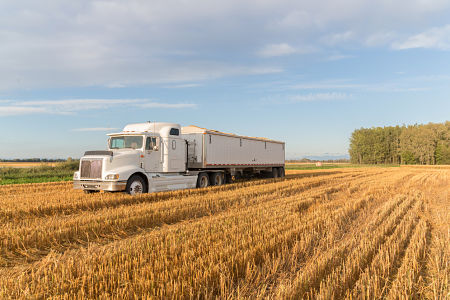Ag haulers face capacity issues across the nation
As the nation’s economy shakes out of its pandemic-induced doldrums, the agriculture industry, and specifically agricultural haulers, are coping with a host of challenges.
As demand for farm products has increased, a supply chain that went partially dormant for more than year has struggled to shift back into high gear.
Andrew Walmsley, director of congressional relations for the American Farm Bureau, addressed the issue in an interview with Trucker.com.
“We’re a three-legged stool, when it comes to transportation — surface transportation, waterway and rail. They all kind of balance each other. As we get challenges in any one of those, or if any one of those legs on that three-legged stool comes apart, we’re on our ass in a lot of ways,” he said. “We’re a really productive country, and 96 percent of the world’s mouths are outside of our borders. So, having the ability to get to those customers is key.”
The federal government has made some temporary fixes, waiving hours-of-service regulations for some agricultural products and meeting with stakeholders in both the agriculture and transportation sectors to explore ways to kick start supply chains.
The National Cattlemen’s Beef Association (NCBA)is backing legislation that would make those temporary adjustments permanent.
One piece of legislation backed by NCBA is the Haulers of Agriculture and Livestock Safety Act (HAULS) which would expand the current 150 air-mile agricultural commodity exemption to 300 air-miles to the back end of hauls.
NCBA is also pushing for exceptions for electronic logging devices (ELDs) for livestock haulers who must offload cattle within certain timeframes.
On a larger scale, the Council of Supply Chain Management Professional’s annual State of Logistics Report says logistics companies will need to adapt to survive in a post-pandemic world.
“Resiliency, innovation, technology, and close collaboration with shippers have all been essential to weathering the rapidly changing market demands up and down the supply chain,” said Andy Moses, senior vice president of sales and solutions at Penske Logistics, in a release presenting the report. “We see this continuing as supply chains reset and adjust to a new normal as consumer preferences and expectations have reshaped the future of the supply chain during the pandemic.”
Top findings from the report include:
- The report predicts U.S. GDP will grow by more than 7.7 percent in 2021 as fiscal stimulus, rising consumer spending and low rates buoy sales and production.
- This will likely lead to rising inflation which could prompt monetary tightening from the fed.
- Trucking volumes are up and so are rates, so shippers will likely try to use technology to improve efficiency and push costs down.
- E-commerce jumped 33 percent to $792 billion or 14 percent of all retail sales, putting more pressure on shippers to satisfy customers. Look for intense investment and innovation around last-mile delivery models.
- Ocean and air freight got disrupted and now must contend with intense delays and bottlenecks.
Overall, the report suggests volatility will remain in the market for the near term.
“In 2021, demand stays varied by supplier sector, transportation mode, and geography. Sudden jumps and dips will result from unpredictable, uncontrollable events. Shippers and carriers alike should plan for optionality in the face of instability. Logistics, like the economy, is in the midst of another wild ride in 2021,” the report stated.
Kevin Smartt, chairman of the National Association of Convenience Stores, says resiliency is the key.
“Our industry’s resilience has been on display throughout the pandemic and is even more apparent now as the economy continues to bounce back. The value of convenience has never been higher, and the innovation within our channel to continually reinvent convenience to benefit our 165 million daily customers astonishes me. I look forward to a strong rest of 2021 and beyond,” he said.






